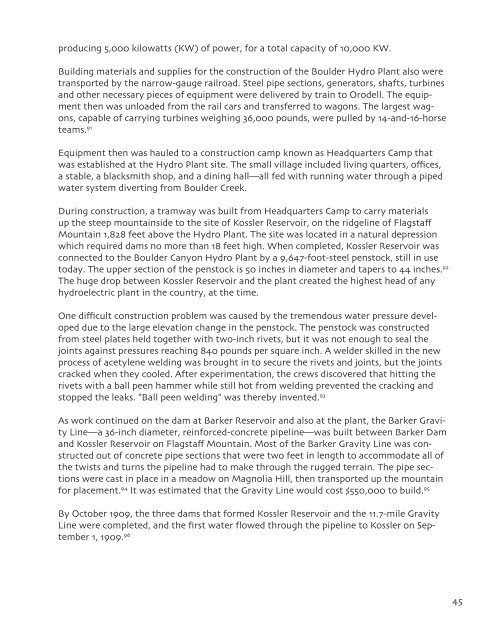Create successful ePaper yourself
Turn your PDF publications into a flip-book with our unique Google optimized e-Paper software.
producing 5,000 kilowatts (KW) of power, for a total capacity of 10,000 KW.<br />
Building materials and supplies for the construction of the Boulder Hydro Plant also were<br />
transported by the narrow-gauge railroad. Steel pipe sections, generators, shafts, turbines<br />
and other necessary pieces of equipment were delivered by train to Orodell. The equipment<br />
then was unloaded from the rail cars and transferred to wagons. The largest wagons,<br />
capable of carrying turbines weighing 36,000 pounds, were pulled by 14-and-16-horse<br />
teams. 91<br />
Equipment then was hauled to a construction camp known as Headquarters Camp that<br />
was established at the Hydro Plant site. The small village included living quarters, offices,<br />
a stable, a blacksmith shop, and a dining hall––all fed with running water through a piped<br />
water system diverting from Boulder Creek.<br />
During construction, a tramway was built from Headquarters Camp to carry materials<br />
up the steep mountainside to the site of Kossler Reservoir, on the ridgeline of Flagstaff<br />
Mountain 1,828 feet above the Hydro Plant. The site was located in a natural depression<br />
which required dams no more than 18 feet high. When completed, Kossler Reservoir was<br />
connected to the Boulder Canyon Hydro Plant by a 9,647-foot-steel penstock, still in use<br />
today. The upper section of the penstock is 50 inches in diameter and tapers to 44 inches. 92<br />
The huge drop between Kossler Reservoir and the plant created the highest head of any<br />
hydroelectric plant in the country, at the time.<br />
One difficult construction problem was caused by the tremendous water pressure developed<br />
due to the large elevation change in the penstock. The penstock was constructed<br />
from steel plates held together with two-inch rivets, but it was not enough to seal the<br />
joints against pressures reaching 840 pounds per square inch. A welder skilled in the new<br />
process of acetylene welding was brought in to secure the rivets and joints, but the joints<br />
cracked when they cooled. After experimentation, the crews discovered that hitting the<br />
rivets with a ball peen hammer while still hot from welding prevented the cracking and<br />
stopped the leaks. "Ball peen welding" was thereby invented. 93<br />
As work continued on the dam at Barker Reservoir and also at the plant, the Barker Gravity<br />
Line––a 36-inch diameter, reinforced-concrete pipeline––was built between Barker Dam<br />
and Kossler Reservoir on Flagstaff Mountain. Most of the Barker Gravity Line was constructed<br />
out of concrete pipe sections that were two feet in length to accommodate all of<br />
the twists and turns the pipeline had to make through the rugged terrain. The pipe sections<br />
were cast in place in a meadow on Magnolia Hill, then transported up the mountain<br />
for placement. 94 It was estimated that the Gravity Line would cost $550,000 to build. 95<br />
By October 1909, the three dams that formed Kossler Reservoir and the 11.7-mile Gravity<br />
Line were completed, and the first water flowed through the pipeline to Kossler on September<br />
1, 1909. 96<br />
45



